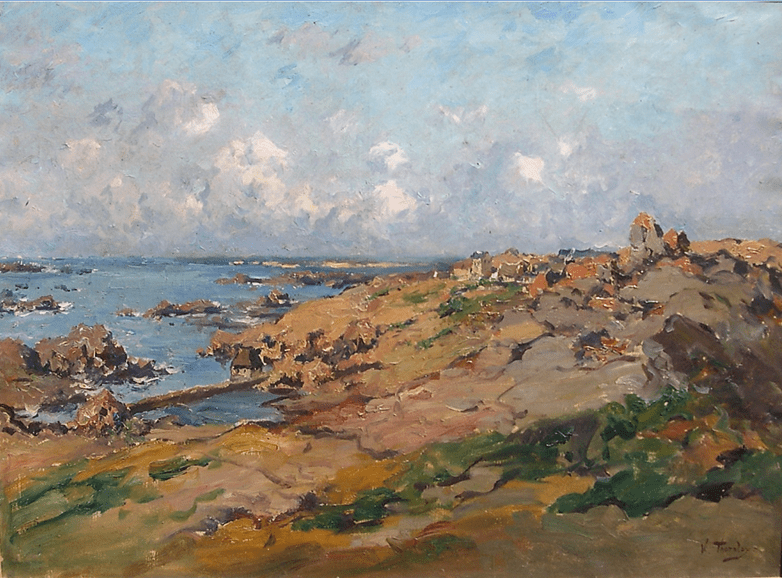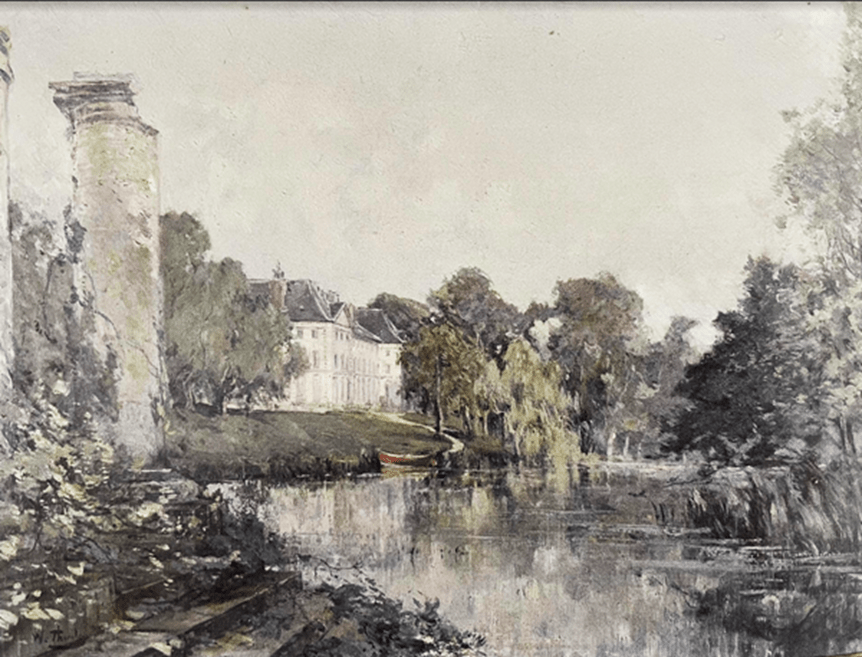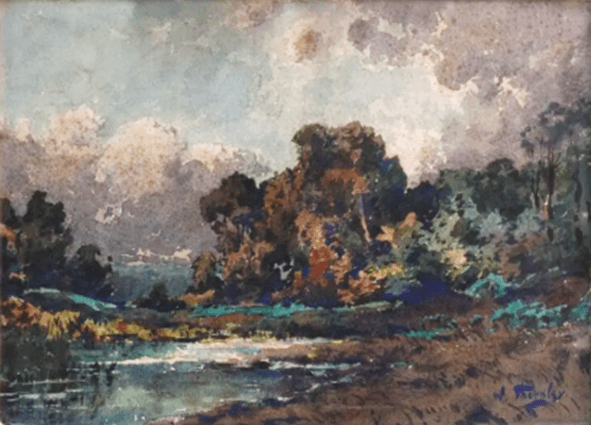Le Birlot. Huile sur toile (60x81cm). Visuel (Collection privée) présenté avec l’aimable autorisation de Maître Philippe Rouillac, Commissaire Priseur exerçant à Vendôme (*) Ce tableau, signé en bas et à droite, a été réalisé après 1900.
Il représente, en haut et à droite, le quartier du Birlot dont les maisons surplombent la mer. En contrebas on aperçoit le moulin à marée, dont la construction résulte d’un contrat qui aurait été signé en 1633 entre le duché de Penthièvre et Jan de Tanouarn, de son état meunier. Le transbordement des marchandises (blé ou farine) entre les bateaux et le moulin était assuré grâce à une porte haute donnant sur le vide.
La perspective retenue par le peintre attire l’œil, au-delà des enrochements situés au premier plan, vers l’horizon qu’il traduit par un léger trait indigo. William Thornley nous offre ici, comme c’est souvent le cas dans ses compositions, un ciel particulièrement soigné, chargé de nuages vaporeux qui évoluent délicatement dans l’azur.
William Thornley fit de nombreux séjours en Bretagne dont un, juste avant le début de sa carrière officielle, en 1877.
Ceci étant, le format de la signature figurant sur cette œuvre est d’après 1900. D’autres séjours de Thornley en Bretagne auront lieu, parfois accompagné par son élève, Félix robin, entre 1900 et 1932. Une aquarelle intitulée « Rochers au Phare du Paon » est datée au dos de 1912. Le journal « L’Echo Pontoisien » (édition du 9/10/1913) mentionne le retour du peintre après un long séjour prolongé en Italie, en Autriche et en Bretagne. Une aquarelle « L’Ile de Bréhat » figure dans le catalogue d’une vente réalisée à Pontoise (Val d’Oise) le 18 décembre 1921. Une autre œuvre sur Bréhat figure également dans une exposition-vente tenue à son atelier d’Osny (Val d’Oise) en juin 1924.
Cette huile (Le Birlot), de mon point de vue, est à dater probablement entre 1910 et 1925.
(*) Cette huile figure également dans un catalogue de visuels consacrés à l’Ile de Bréhat (Musée virtuel de l’Ile de Bréhat)

« Le Birlot« . Oil on canvas (60x81cm). Visual (Private collection) presented with the kind authorization of Maître Philippe Rouillac, Auctioneer working in Vendôme (*) This painting, signed lower and right, was produced after 1900.
It represents, at the top and to the right, the Birlot district whose houses overlook the sea. Below we can see the tide mill, the construction of which is the result of a contract which would have been signed in 1633 between the duchy of Penthièvre and Jan of Tanouarn, from his milling state. The transshipment of goods (wheat or flour) between the boats and the mill was ensured thanks to a high door opening onto the void. The perspective retained by the painter draws the eye, beyond the rocks located in the foreground, towards the horizon which he translates with a light indigo line. William Thornley offers us here, as is often the case in his compositions, a particularly careful sky, full of vaporous clouds which evolve delicately in the azure.
William Thornley made numerous stays in Brittany, including one, just before the start of his official career, in 1877.
This being said, the format of the signature appearing on this work is after 1900. Other stays of Thornley in Brittany took place, sometimes accompanied by his student, Félix robin, between 1900 and 1932. A watercolor entitled “Rochers au Phare du Paon” is dated 1912 on the back. The newspaper “L’Echo Pontoisien” (edition of 9/10/1913) mentions the painter’s return after a long extended stay in Italy, Austria and Brittany. A watercolor “L’Ile de Bréhat” appears in the catalog of a sale held in Pontoise (Val d’Oise) on December 18, 1921. Another work on Bréhat also appears in an exhibition-sale held at his Osny workshop (Val d’Oise) in June 1924.
This oil (Le Birlot), from my point of view, probably dates between 1910 and 1925.
(*) This oil also appears in a catalog of visuals dedicated to the Ile de Bréhat (Virtual Museum of the Ile de Bréhat)



